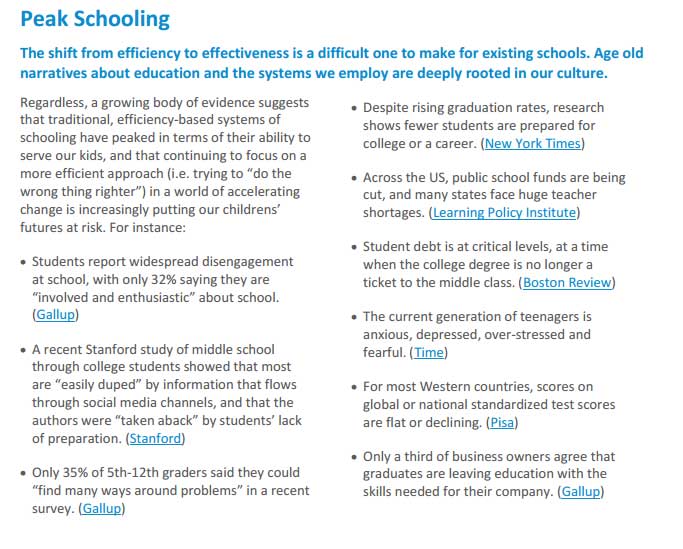Is Your School Modern? Check Out These 10 Principles to Find Out

Innovative educators understand that surprisingly little has changed in how school is done today versus the last century. It is clear we must update and/or throw out outdated practices and possibly do something radically different. But what does it really take for a school to be modern? This is the question educators and authors Will Richardson and Bruce Dixon answer in their white paper 10 Principles For Schools of Modern Learning: The Urgent Case for Reimagining Today’s Schools.
Not only do the authors outline 10 principles for school communities to focus on as they get started in creating an education model that serves the needs of today's students, but they also provide evidence to make the case in support of reimagining schools.
Take a look at the 10 principles and think about them in relation to schools or school models in which you teach or are familiar.
Read the full white paper to discover why each Principle is important and steps to put it into action.

Educators familiar with innovative schools / models may be able to immediately make connections between the models / schools they know and these principles. For example, Science Leadership Academy immediately comes to mind as I read several of these ideas. For example they discuss and have core values posted in every classroom (Principle 1) and they think deeply about their mission and vision and update it with the passage of time (Principle 2).
A useful exercise for schools interested in starting on this journey could include that they:
1) Select the principles they would like to start with
2) Discuss what that could look like
3) Come up with a strategy to put that in action
Tools and ideas to transform education. Sign up below.
4) Check in to evaluate progress and success
The white paper also provides compelling evidence for why we need to reimagine schools. Here is an overview of
that.

Visit page 5 of the whitepaper where you can access the source behind each piece of evidence.
Will Richardson and Bruce Dixon make a solid case but what would it take to really put these principles into effect? There would certainly need to be buy in from the top down, bottom up, and throughout the school community. But how do you get that buy in and how do you move from reimagining school to putting new learning environments into place? The authors are inviting education leaders to join them on an 8-week journey that is focused on the “how” of change, by thinking, doing, creating, and sharing. The first round is full, but you can sign up for Change.School 2 (CS2) starting in early June and running through late July. You can find information about Change.School and this and future opportunities at https://change.school.
Lisa Nielsen writes for and speaks to audiences across the globe about learning innovatively and is frequently covered by local and national media for her views on “Passion (not data) Driven Learning,” "Thinking Outside the Ban" to harness the power of technology for learning, and using the power of social media to provide a voice to educators and students. Ms. Nielsen has worked for more than a decade in various capacities to support learning in real and innovative ways that will prepare students for success. In addition to her award-winning blog, The Innovative Educator, Ms. Nielsen’s writing is featured in places such as Huffington Post, Tech & Learning, ISTE Connects, ASCD Wholechild, MindShift, Leading & Learning, The Unplugged Mom, and is the author the book Teaching Generation Text.
Disclaimer: The information shared here is strictly that of the author and does not reflect the opinions or endorsement of her employer.
Lisa Nielsen (@InnovativeEdu) has worked as a public-school educator and administrator since 1997. She is a prolific writer best known for her award-winning blog, The Innovative Educator. Nielsen is the author of several books and her writing has been featured in media outlets such as The New York Times, The Wall Street Journal, and Tech & Learning.
Disclaimer: The information shared here is strictly that of the author and does not reflect the opinions or endorsement of her employer.
